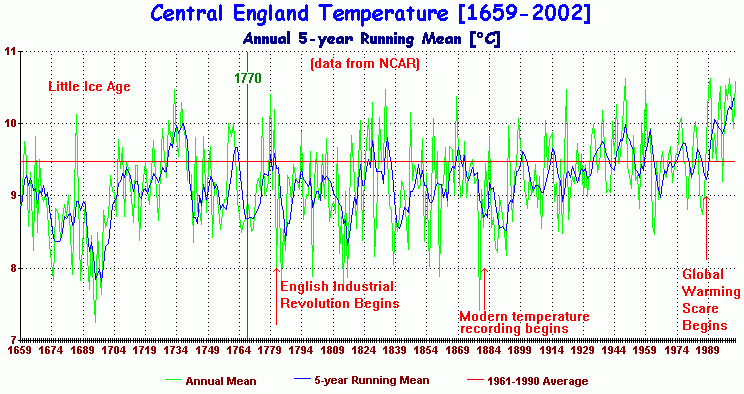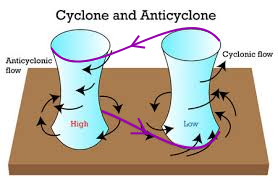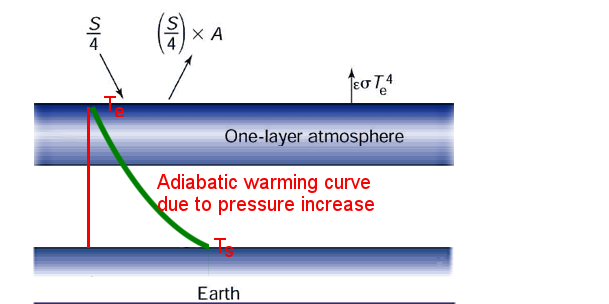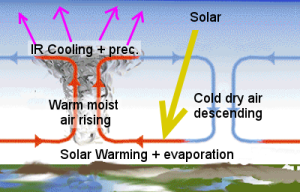Following yesterday’s article about lapse rate I was frustrated by what I left out. So as a mental exercise, I set myself the challenge of putting down something about all the major things that affect climate and particularly global temperature.
Summary
The main things affecting global temperature can be categorised as:
- Incoming solar radiation
- The albedo of clouds and the surface
- The pressure and density of the atmosphere in terms of IR interactive molecules and this can be described using the concept of the effective radiation height
- The lapse rate
- Natural variation (including ocean currents)
Natural Variation
The title was originally “a complete theory of global temperature change” … and if I were being cheeky, I’d have stopped here. Because for all reasonable purposes the global temperature (shown in via the CET proxy below) is changing as one would expect for a system that is only affected by natural variation.
 Natural variation is really just a term to describe every change that occurs which we are unable to predict. It is what we see on a long term graph of global temperature like that of CET above. And as the pause shows, no climate model has shown any skill at predicting any change in the climate before it happens.
Natural variation is really just a term to describe every change that occurs which we are unable to predict. It is what we see on a long term graph of global temperature like that of CET above. And as the pause shows, no climate model has shown any skill at predicting any change in the climate before it happens.
The failure of all the models clearly showed, we don’t know a lot about our climate … except the fact it has always varied. We’re starting to get an idea what some of those reasons may be, we are starting to get explanations of what happened in the past (or at least I am) but we still can’t use most of this knowledge to predict what will happen. (And as no one else will say it: I’ve not seen anyone with quite the same understanding I have! :).
Predictable variability
However, unlike other systems like for example “turbulence” in hydrology, some of the “turbulence” we see in climate comes as things we can identify. A good example is the El Nino. This is “pseudo-predictable” in the short term – so its effect could be separated out from general background variation, but it is unpredictable at any point in the distant past. So, at times this natural variation can be semi-predictable, but over most time periods it is unpredictable.
Similarly solar variation, volcanoes, and even Milankovitch cycles. To a varying degree we can separate out these effects (particularly in hindsight), but in a general sense they are all things just adding to the variation in the climate and should be termed natural variation.
Finally, like the butterfly effect, small things matter for the climate. The world is full of things that are constantly changing. Elephants in Africa knock down trees, that forms barren grasslands. That in turn leads to a drop in elephant numbers and then the tree regrow. There are numerous pseudo predictable cycles like this. Each has a small effect on the climate, but together the combined effect of all these small changes is massive and incalculable. So, natural variation is both things that can be potentially measured, but also many many things that either can’t be measured or are too many to measure.
Solar radiation
We know the average current level of electromagnetic radiation leaving the sun. This is assumed to be fair constant. However, I would not be surprised if there is long term (millennium) variation. In reality, the sun itself is an “atmosphere” … although in this case of liquid hydrogen. And, just as the earth
Milankovitch/Orbital variations
The distance from the earth to the sun affects the % of radiation leaving the sun that hits the earth. In addition, the tilt of the earthy is important because this changes the level of summer versus winter heat. And because the northern hemisphere has more land surface and the southern hemisphere has more sea, if the earth is closer in the northern summer, the radiation hits more land and visa versa if it it closer during the southern summer, it hits more ocean. Because land and ocean absorb radiation differently, the timing of the summers relative to the nearest approach of the earth to the sun has a significant effect. For example, all ice-ages end at the point when the orbital cycle is going from stronger sun in the southern summer to a point where we have stronger sun in the northern summer.
Solar Activity and Cosmic rays
I love the term “cosmic ray”, because I’m sure the reason most “Oh we can’t not be PC” academics don’t accept the theory is purely because it sounds rather comic book.
However, the effect is real, it is tangible and it is paradoxically one of the most rigorously tested aspects of climate. In the terms of those doing the testing “it hasn’t been disproved”. In terms familiar to us sceptics knowing the usual standards of climate “it is the most thoroughly well established phenomenon of climate”.
The effect is simple to explain (but complex to follow). The Galaxy is filled with sources of “cosmic rays” which are just very high energy particles. Sunspots are associated with magnetic fields. These magnetic fields shield the earth and so, when there are sunspots the earth is shielded and the atmosphere gets less cosmic rays. As an aside, it’s this cosmic ray activity that creates the Carbon 14 that archaeologists use to day ancient organic material. So, we are always getting cosmic rays, its just that their intensity varies (causing no end of issues for archaeologists – as you can literally get two date for the same ratio of C14).
When cosmic rays reach the atmosphere, they blast apart molecules creating ionised particles. These particles then attract H2O – and if there is enough of this H2O present, they will tend to clump together forming water droplets. Thus the effect of cosmic rays is to create cloud condensation nuclei which tends to cause water to condense quicker.
The result of this is to generally lower the cloud level (see clouds). This in turn reduces the lapse rate from the earth’s surface to the “effective radiation height” (i.e. the cloud top), and thus the greenhouse effect is reduced causing global cooling.
Meteorites
As I’m starting in space, I will briefly mention the potential impacts of meteorites. First, they can add dust to the atmosphere (see dust). Next if e.g. they are frozen CO2, they can add additional gas and/or they can blast off parts of the atmosphere reducing global pressure (see Global pressure). Also, there is the potential for orbital dust. We don’t have significant dust at the moment (or I’ve not heard it claimed we have), but this could have been different in the past change and it would block out sunlight.
The Greenhouse Effect
As most people who might this will know the greenhouse effect doesn’t heat the way a greenhouse does (which is mainly to trap air), nor unfortunately does it really work the way it is portrayed through most blogs. A far better term would be “thermal blanket”, because the key to understanding the “greenhouse” effect is that the temperature of the effective “radiative surface” of the planet must be (on average) 255C in order for incoming solar radiation and outgoing IR to match.
 However the “effective radiative surface” is not a single level. Instead it’s a bit like looking into a wood. In a dense summer wood as shown right, we can’t see far into the wood. We could e.g. calculate the average distance it is before we reach a solid object that blocks are view – or to put it another way – something from which light leaves the wood and arrives at our eyes.
However the “effective radiative surface” is not a single level. Instead it’s a bit like looking into a wood. In a dense summer wood as shown right, we can’t see far into the wood. We could e.g. calculate the average distance it is before we reach a solid object that blocks are view – or to put it another way – something from which light leaves the wood and arrives at our eyes.
 However, the same wood in winter would look different. Now the wood is so “thin” we can even see right through to the other side. Now, for the same density of trees, the effective distance we can see has vastly increased. But even if all the trees were extremely thin … but there was a significant number of e.g. ever green hollies, we’d still not be able to see through a deep wood.
However, the same wood in winter would look different. Now the wood is so “thin” we can even see right through to the other side. Now, for the same density of trees, the effective distance we can see has vastly increased. But even if all the trees were extremely thin … but there was a significant number of e.g. ever green hollies, we’d still not be able to see through a deep wood.
The same principle worlds with so called “Greenhouse” gas molecules. Their effect is to reduce the distance that we can “see into” the atmosphere atmosphere in the IR. The result is that what we would see from outside changes depending on the density of IR interactive molecules. Thus they have only two effects (neither really that should be described as heat trapping )
- IR interactive molecules (Greenhouse gases) raise the effective IR emission height of the atmosphere. All other things being equal (like the temperature of the atmosphere at that level) THEY WOULD HAVE NO EFFECT ON OUTGOING HEAT
- IR interactive molecules (Greenhouse gases) tend to block the “view” of the ground. However, all other things being equal (like the temperature of the atmosphere at that level) THEY WOULD HAVE NO EFFECT ON OUTGOING HEAT
- IR interactive molecules absorb some incoming solar. However, as that occurs high up in the atmosphere it is largely re-emitted causing NO CHANGE IN TEMPERATURE
How then do IR interactive gases (greenhouse gases) cause the surface to be warmer?
The reason we get a greenhouse effect, is not because of any heat trapping effect (although to confuse the issue they do lead to heat being trapped). The reason the surface is warmer than the 255K that it would be without an atmosphere, is because of the lapse rate from the surface to the effective radiation height. That effective height is the sum over all outgoing contributions including some from the ground. However, like the wood, the more “dense” the wood – or the more “evergreens” in a winter wood, the more what we see … the light coming from the wood … originates from further out.
And so, if the effective radiation height increases … because the temperature drops with height (at least in the lower levels that are important), there is a greater drop from the surface to the effective radiation height.
And because there is a greater drop from the surface to the effective radiation surface which we know must be 255 then the surface must be warmer.
In order for that to happen, heat is trapped, but contrary to the “heat trapping” model which puts the emphasis at what gets away from the earth – the real change is at the top of the atmosphere where there is a slight rise in the level from which IR escapes. For a doubling of CO2 that effect is around 100-200m.
Clouds
The first major obstacle to visible light hitting the earth is the cloud layer. Clouds are basically part of the cooling mechanism of the earth … which annoyingly also act to warm us. First I need to explain why water vapour is so important.
Water vapour cooling
At all times, clouds are one of the main mechanisms for losing heat via IR. That is because clouds are a vector to take heat from the surface where water is evaporated (particularly over seas and lakes and vegetated areas). Most people readily understand the idea that evaporation cools – and thus it removes heat from the local environment when it cools. What is less intuitive, is that condensing water then delivers energy to the local environment. The reason for this, is that condensation doesn’t make anything warmer … and usually we associate condensation (like fog) with cold. But in truth, the effect of the moist air is to stop something else getting as cold as it would be without the condensation.
So, if on a cloudless night, the air is moist, there will be fog and the condensation of that water will deliver heat to the air making it warmer than it would otherwise be. So, condensing cloud “warms” – but only in the sense that in a cooling environment the condensation makes it warmer than it would otherwise be.
So, water is a way heat is taken from the surface of the earth and delivered to the cloud layer. So, that heat is taken directly above the bulk of the atmosphere where it is delivered via condensation to the cloud layer which is then a fantastic emitter of IR.
So, moist air rises, and when it condenses it forms an almost opaque barrier which in effect becomes new “planet surface” (where there is cloud) so effectively radiation either occurs from this surface or from the much smaller amount of “greenhouse” gas above it. Thus the effective radiation height increases with cloud cover.
However, the very fact the clouds form and become very effective IR emitters, means that the rate of IR loss increases and the rising air cools even more rapidly. This tends to concentrate the level at which clouds form. Eventually, air and water separates, as water starts descending (potentially growing till its heavy enough to break out of the rising air column and become precipitation). That leaves the air rising until it reaches the upper levels of the cloud where (in day) it is warmed. This quickly stops further condensation and helps to form a distinct cloud top.
Types of Atmospheric circulation
There are various types of atmospheric circulation which each create their own pattern of meteorological disturbance

Hadley cell structure of the atmosphere showing three zones to north and south of equator with winds in opposing directions in each cell
Hadley Cells
The Hadley cell structure is important because it is these largescale air movements that tend to drive ocean currents. And so a northward movement air current – whilst in itself carrying heat northward toward the pole, by driving far more heat-dense water, it can vastly increase the heat flow.
The Hadley cells arise because the equator is heated most strongly by the sun, and the poles least strongly. This results in a general circulation pattern of warm rising air at the equator and descending cool air at the poles. And this would be the general pattern on the earth except for one small detail … the earth is spinning and due to the Coriolis effect as the (hig level) air starts heading toward the equator – it swerves to one side (to the right heading northwards). And, rather than reaching the pole, it ends up going in a circle. Fortunately, having cooled it sinks down (at the latitude of the Sahara) and so avoids colliding with other air coming out from the pole. However, perversely, this now creates an area of high pressure over the Sahara’s latitude. This the causes air to be pushed out at low levels and head northwards – where around the latitude of Britain, it encounters the cold air being pushed out at low levels from the pole. Again the Coriolis effect comes in, so by the time the air reaches us the southerly winds are coming from the SW and the northerly winds from the NE. Well, as you might expect, there’s an almighty collision, we get masses of turbulence – but eventually they both rise up. The warm moist air from the south then dumps its moisture over Britain and then goes home .
(anti) Cyclones

Generalised path of air flow between cyclones and anti-cyclones. However note that for simplicity I’ve shown only one pair showing one cycle. In reality descending air seldom returns to the same ant-cyclone from where it originally ascended.
These are important because often the source of warmth is from ocean currents. The result is that (anti) cyclones tend to be persistent features lasting for days or even weeks.
There is not really a fundamental difference between the overall Hadley cell structure and (anti) cyclones because the Hadley cell structure gives rise to many ant-cyclones and cyclones. It’s just that a cyclone is a more localised effect. And not all cyclones are part of the Hadley cell structure, and it is possible to get air circulation without the formation of recognisable cyclones (such as descending high pressure forming over deserts).
Like the Hadley cells, cyclones & anticyclones are the result of solar heating in some areas and cooling in others. This time however, we should see the heating as warming the air (and causing evaporation) at ground level. This warm moist air then rises. This causes an “inverted whirlpool”. The heat is lost in the cloud which then emits it to space. More cooling takes place via IR and eventual the air descends in a high pressure area, again following a curved trajectory.
Sunny day clouds
Finally the most localised & most ephemeral effect is that of the rising thermals that are formed on sunny days.
These are important, because they are so ephemeral and last less than a day. The result is that as they form during the daytime, they tend to block out solar, but because they dissipate rapidly they do not have the same warming effect as other types of circulation.
These are caused where there are areas of intense local heating. Apparently glider pilots know even the type of fields that give rise to them! Again, for every rising column of air there must be one descending. Which probably explains why we get “cotton wool” type clouds interspersed by clear sky.
Effects of Clouds
Clouds act in three basic modes:
- During the day, more cloud cover tends to block out sunlight reflecting it back to space.
- The effect of increasing cloud cover is to raise the effective radiation height and because there is now a greater greenhouse temperature from the surface to the effective radiation height, this leads to an increase in the surface temperature (something we can literally feel in the difference between a cloudy and cloudless night).
- If however the cloud cover is “saturated”, the air rising is more moist and/or something like increasing cosmic rays, dust or other condensation nuclei cause the condensation of clouds at a lower level, the effect is that the cloud cover remains the same, but the effective radiation height reduces. This means there is less greenhouse effect and as a result it leads to global cooling.
General effect of rising humidity on a planet
Initially as we go from arid conditions toward one where there are clouds, the effect is to cause clouds to increase their cover and this INCREASES the greenhouse effect – but it also acts to DECREASE incoming solar radiation. If the cloud mostly forms during the day and dissipates at night, the greenhouse effect will be much smaller than if the cloud is persistent.
However, because the cloud layer must have areas of descending as well as rising air, and because descending air is clear of cloud (on earth), there is a fundamental limit to how much of the atmosphere can be smothered with cloud. Now, if more water vapour enters the atmosphere, it can only lead to condensation of water at lower levels. This results in a drop in the level of cloud and so a drop in the effective height of radiative emissions from the earth and a reduced greenhouse effect. The net result is thus global cooling. This is an important if not the most important mechanism that halted the runaway warming that ends each ice-age.
It is also the fundamental reason why we will never see much higher temperatures than we are currently seeing.
Albedo
The biggest impact on albedo of the earth are the white clouds which reflect vast amounts of incoming solar. The next biggest effects are the relative absorption of the sea versus land (for area) and the ice-caps versus sea and/or land (not as important as they form where incoming solar is least). However, a very important contribution comes from the vegetative cover (which absorbs in some colours but tends to reflect in others).
So, having got out of the sun, through the possible dust clouds in space, through the atmospheric clouds and any dust in the atmosphere – if the incoming solar is not reflected back again … it is absorbed.
Atmospheric dust
Dust can directly block out solar, it can also act as cloud condensation nuclei. Dust high in the atmosphere, can also act like a greenhouse gas increasing the effective radiation height. So overall added dust has a cooling effect.
Lapse rate, Evaporation and Moisture
In order to lift a parcel of air against gravity, energy is required. This energy comes from stored heat energy which provides the energy to push outward, expanding the parcel of air and it is this outward pressure or “buoyancy” that is the mechanism by which air rises.
However, all we really need to know is that rising air cools and that for dry air the rate of heat loss is 9.8K/km. However, when it cools sufficiently that the moisture in the air starts to condense, the energy taken away from the plants, sea & lakes and ground (which produces cooling on evaporation) is then delivered into the air reducing the rate of cooling so that the lapse rate for moist air is around 5k/km. The result is that on average the lapse rate is around 6.5k/km. And the greenhouse effect is merely:
Greenhouse effect = lapse rate x He
Where He is the effective radiation height. However, because there are two components to the lapse rate (moist and dry) and there is a sharp change from one to the other at a height we can call Hc. The greenhouse effect is actually the combination of two heights:
Greenhouse effect = He moist lapse + Hc (dry lapse – moist lapse)
And as mentioned earlier, Hc is affected by:
- Atmospheric moisture
- Cloud condensation nuclei (from dust, cosmic rays, etc.)
Atmospheric moisture
The single biggest contribution to atmospheric moisture are the seas (that really needs checking – but being far more sea I’d hope so). However, the single biggest and most changeable factor is the level of plant cover. We see this effect particularly in urban environments where increasing concrete and other man-made surfaces, reduces the availability of plants that take up vast quantities of water and evaporate it to the air. This is the so called “urban heating effect” – an effect caused by lack of vegetation and not as many often think by the absorption of solar. However, we can also see why even fairly urban areas with need cut lawns can have a significantly increased temperature than wild forest. The reason is because there is just so much more evaporative area when there’s a forest compared to a lawn … or even agricultural land with low growing crops.A complementary effect is that of drainage. This tends to dry out land (otherwise no one would do it!). The result is that there is less moisture available for plants and as a result there is less moisture going into the atmosphere.The Greenhouse effect of reducing plants & drainage
Thus the effect of reducing water available to plants through drainage and/or reducing plant cover through agriculture or urbanisation, is to reduce the atmospheric humidity. This in turn means that the change from dry lapse to moist lapse is higher which then means the total greenhouse effect is increased.
Note: this “greenhouse” effect is not the non-scientific doomsday “runaway” heating. Instead, the actual effect is a single step wise and reversible change.
Volcanoes
 Volcanoes are the vents through which the by-products of thermally decomposed materials from the earth’s crust are vented back to the surface. These materials range from lighter rocks through water vapour to gases like CO2. They are the tip of the ice-berg in terms of total flow of materials, because it is also very likely that oils & “natural gas” are formed this way.
Volcanoes are the vents through which the by-products of thermally decomposed materials from the earth’s crust are vented back to the surface. These materials range from lighter rocks through water vapour to gases like CO2. They are the tip of the ice-berg in terms of total flow of materials, because it is also very likely that oils & “natural gas” are formed this way.
Atmospheric Pressure
Just as increasing the density of greenhouse gas will increase the effective radiation height, so increasing atmospheric pressure will also increase the effective radiation height. There is currently no evidence that global pressure is changing … but there is also no evidence at all that anyone has looked to see if global pressure is changing.
However, for all realistic purposes (unless we get something like a massive meteorite blasting off the atmosphere) the planet is sealed against air loss out to space.
However that does not mean the atmosphere is sealed, because the atmosphere can easily “leak into” the ground. That is to say, Oxygen can combine with Irons to form compounds that are then locked into geological processes. Nitrogen can form nitrates and again get locked up.
Over long geological periods it is therefore almost certain that changing atmospheric pressure has resulted directly to a change in the Greenhouse effect. What is less clear is how short a period such affects could occur.
However, as each volcano adds to the atmosphere, as we can see thermal vents under the oceans emitting gases … we know that gases are always escaping from the core – and sometimes in huge quantities in volcanoes. We also know that Nitrogen is being sucked out of the air by some bacteria and oxygen when it oxidises anything. We also know that nitrates then break down to reform nitrogen and that (after forming CO2) plants release Oxygen back to the atmosphere.
The mechanisms for significant changes to the greenhouse effect are there, but the rate is unknown. It certainly has an effect over long geological periods, it may also have an effect over the 100 year long ice-age cycle.
The diagram above right turns the earth inside out. The core is now outside the planet and we could visualise gaseous exchange into and from this now “external” space.
Ocean currents

Gulf Stream shown as hot (red) toothpaste like stream coming out of Gulf of Mexico and heading NE until it disappears.
As I mentioned above ocean currents are driven by the winds. But what I’ll add here is that direct solar heating will also drive ocean currents … and heating doesn’t just come from above. Like the whole crust, there is a constant flow of heat from the core.
One important way they affect climate is by transporting heat from equatorial regions toward the poles as shown by the picture of the real Gulf Stream shown to left.
Note the Gulf stream is the thin stream coming out the Gulf of Mexico which disappears soon after leaving America. The general circulation we get in Britain is the “North Atlantic Drift” – which is part of a much larger effect.
Oceanic Instabilities
One of the biggest known sources of natural variation derives from the oceans. (not necessarily the biggest just the biggest we know about). Off the top of my head we have El Nino, AMO (The Atlantic Multi-decadal Oscillation), PDO (the Pacific Decadal Oscillation) .
The way these work as external drivers to surface temperature is by redistribution of the heat. So, e.g. if there is a thin layer of very warm water across a large part of the oceans, this will raise global temperature. If however the same total heat content is more evenly dispersed in the ocean, the result is that ocean surface temperature will reduce leading to global cooling.
But, fundamentally, for such noise sources, we need to have instabilities. But if we only consider solar heating of the oceans, we find that this tends to warm the top layer making it stable. If we then consider the dominant trade winds – they tend to drive water constantly and whilst they might cause warm water to be driven north – where it cools and so sinks down allowing new water to arrive, again there is no fundamental reason to see instability.
Wind induced instability
One possible mechanism is that the warmth from the ocean itself affects the climate – in such a way as to tend to reduce wind speeds and thereby reduce the push of the wind on the water and reduce the current. This would then have to increase wind speeds … and the cycle would restart.
Wind driven currents tend to force down warmer water – which would only be kept in place as long as the wind blows. If however there is a lull, the warm water would spread out causing a significant change in oceanic surface temperature and effective temperature.
Salinity induced instability
Salinity is an important fact affecting the density of the water. And salinity can be directly affected by
- Land bases sources of fresh water such as rivers and glaciers (reducing salinity)
- Evaporation of water (increasing salinity & therefore density)
- Biological uptake of minerals (e.g. in shell formation)
- Geological sources such as hot springs adding to the salinity
So amongst various possibilities is that warm water reaching for example the Arctic, leads to melting of the ice. The melting of so much ice with a lower density of salt water then in some way interferes with the current which then tends to reduce the strength of the current and so reduce the amount of warmth and thereby reduce the melting allowing the ice to reform.
Likewise increased precipitation over land can result in areas of low salinity water in the sea. If they reach a sea that is colder, they may sink below the water. If so they can accumulate until they warm sufficiently, whereupon they will then rise to the surface.
Crustal heating induced instability
We’ve only just started going down into the deepest oceans to have a brief glimpse of what goes on. I’m not aware of any serious attempt to measure just how much heat flow there is. However, as the oceanic crusts are thinner than the continental ones and the oceans cover the largest area, it is certain that most of the heat from the crust flows into the ocean.
So, rather like the scale of crustal gases, the scale of crustal heat is also difficult to measure and we may well find that there is a much higher flow that anyone expected.
But, the importance of this crustal heating is that it comes from the bottom whereas solar heating comes from the. So, whereas solar heating tends to increase the stability of the water column making the top most layers less dense and therefore even more willing to float over the colder layers below, crustal heating tends to overturn the heat column creating instability in the system.
Caterpillars & Long term cycles
It is a simple matter of physics that during the ice-age the crust will cool and that will cause the crust to contract.When it contracts it tends to pull apart at places where the crust is being formed. When we get heating, the expansion tends to cause one tectonic plate to push against another and the result is that one is pushed under the other.
 The total change at the surface is very small, but over the 40,000km of the crust it amounts to a few kilometers of contraction and expansion. However, because during the cooling cycle mid-oceanic crust it formed, the crust cannot expand at the mid-oceanic sites and so it tends to push out at the subduction zones. The result is that the plate shrinks and expands rather in the way some caterpillars move.
The total change at the surface is very small, but over the 40,000km of the crust it amounts to a few kilometers of contraction and expansion. However, because during the cooling cycle mid-oceanic crust it formed, the crust cannot expand at the mid-oceanic sites and so it tends to push out at the subduction zones. The result is that the plate shrinks and expands rather in the way some caterpillars move.
We also know this happens from the correlation of crustal formation at the mid-oceanic boundaries with the ice-age cycle and shown below.

Fig XX Bathymetric and ice-age cycle (CO2) data normalized to a aximum amplitude of 1, and
superimposed
In the cooling phase, the caterpillar effect predominantly affects crust formation processes in a way that has very little if any affect on climate. So, in this phase, the cooling global temperature is driven by some other process.
However, we know that a modest warming caused by changes in the orbital triggers a massive change. And not every similar change of the Milankovitch cycle triggers the end of the ice-age, but sooner or later one does. It appears that the Milankovitch warming cannot trigger a new warming period until the rate of cooling has diminished sufficiently that the small warming “tips” the crust into expanding.
This expansion then seems to lead to runaway warming. Several mechanisms are possible:
- Direct greenhouse warming through increased pressure
- Direct greenhouse warming through higher CO2 (a very small effect)
- Changes to atmospheric or oceanic circulation patters (e.g. Hadley cells)
- Changes to CO2, in turn increasing plant growth and thereby increasing the amount of moisture in the atmosphere. This in the drier climate during an ice age may well create significant warming as cloud spreads out (increasing the effective radiation height).
However, not only must we explain runaway warming … but almost completely forgotten by everyone … we must explain why warming stops and we always tend to get roughly the same temperatures in the inter-glacials. The most likely candidates for this are:
- That once cloud cover “saturates”, further (plant derived) moisture in the atmosphere tends to reduce the level of the cloud … thus lowering the effective radiation height and thereby causing global cooling.
- Massive change in oceanic or atmospheric circulation (like a change in the Hadley cell structure).







Pingback: The theory that will bring down global warming | Scottish Sceptic
So where does polar vortex ozone come into play. Eg. https://reality348.wordpress.com has plenty of data…no models.
You’ll have to expand a bit – or are you doing what I often do which is to link to one of my articles – which given its a good article is fine – but it saves me scratching my head.